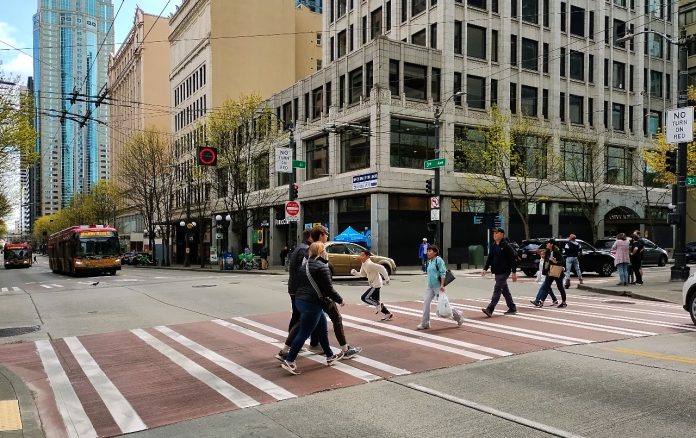
Mayor Bruce Harrell Thursday unveiled a modest renewal package for a transportation levy succeeding 2015’s Levy to Move Seattle, set to expire at the end of this year. The $1.35 billion proposal would expire in eight years, compared to nine for Move Seattle, increasing the amount of property tax revenues the city would collect on a per-year basis. City officials say the package beats inflation by around 10%, falling well short of a dramatic increase in funding that many transportation advocates argue is the bare minimum that Seattle needs to keep up with basic infrastructure needs in a fast-growing city.
The proposal released Thursday is a draft that will be available for public comment, with the potential for refinements to individual programs and spending priorities possible before the finalized levy ordinance heads to the Seattle City Council sometime in May.
If approved by voters, the renewal — for now just being called Seattle’s “Transportation Levy Proposal” — would allow the Seattle Department of Transportation (SDOT) to continue receiving around 30% of its overall budget via a dedicated property tax levy, as the City faces significant potential budget cuts elsewhere due to a quarter-billion-dollar deficit in the City’s general fund projected for 2025 and increasing in 2026.
The initial proposal is less prescriptive than the Move Seattle Levy was. The City highlighted a few key projects Thursday that it plans to tackle under a levy renewal, but many of the proposed buckets of funding don’t have specific projects attached to them yet. SDOT officials said this was by design, but that in response to community feedback over the next few weeks they may decide to provide more specific project lists.
“I think we do want to have more flexibility to make these investments in the places that are most needed as the city grows,” SDOT Director Greg Spotts said in a press briefing Thursday morning. “If you wire them all in right now, then you may not be poised to adapt to places that become more dense and have more multifamily housing there.”
Mayor Harrell’s growth strategy in his One Seattle Comprehensive Plan also has some fuzzy edges right now, which may help explain the fluid approach.
SDOT did poll on a hypothetical $1.7 billion levy, as well as an option that only manages to keep up with inflation at $1.2 billion. Both polled well above water and appeared very likely to pass, but the smaller package did enjoy a larger margin. Advocates pushed the City to go bigger at $3 billion focused on pedestrian, bike, and transit projects.
Levy renewal is heavy on maintenance and preservation

Harrell’s levy proposal heavily emphasizes spending on maintaining the existing transportation system, with $423 million proposed for street repaving and another $218 million on bridge upkeep. An additional $100 million would be spent on upgrading and replacing traffic signals, including adding technology to more directly manage vehicle throughput and signal control, as the city has already done on corridors like Mercer Street and Denny Way.
Repaving projects being eyed include Rainier Avenue’s busy northern segment, 35th Avenue SW in West Seattle, multiple corridors in Georgetown including Ellis Avenue S and East Marginal Way S, and streets downtown like the Elliott and Western Avenue couplet and James Street. All of these projects will likely have safety and transit upgrade components, but the details of exactly what that looks like will be left to another day. Overall, 16 streets would see corridor-wide repaving work, where we should expect the biggest debates over potential changes, while another 50 lane miles would see spot paving repairs.
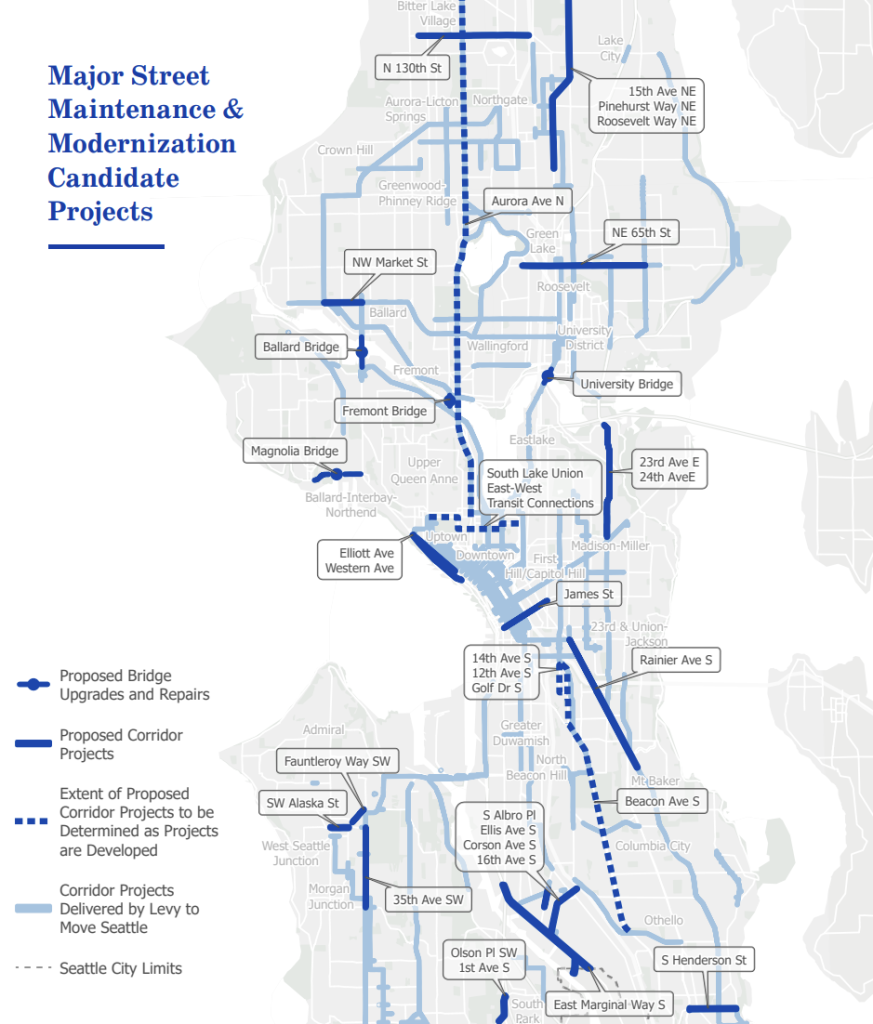
The planned upgrades to bridges include structural repairs on the Ballard and Magnolia bridges, and electrical and mechanical upgrades to the three city-controlled lift bridges across the Lake Washington ship canal: Ballard, Fremont and University. SDOT also proposes using levy funds to develop a preventative bridge maintenance program that stops the city from playing catch-up when it comes to bridge maintenance issues across Seattle’s 140 city-owned bridges.
As for the longer-term replacement needs of the Ballard and Magnolia bridges, the levy does not including any local matching funds for full replacements, but SDOT does plan to use funding to advance replacement projects for four to five structures, including the northern segment of the Elliott Bay seawall in Downtown, to 30% design, work that is likely to include at least one of those bridges.
Freight improvements would see a $25 million investment, a fairly significant scaling-back compared to the $39 million in Move Seattle, after the city prioritized high-profile freight projects like the Lander Street Overpass and the E Marginal Way rebuild in recent years.
Consistent spending on bike and pedestrian improvements
Overall, the levy proposal represents a continuation of what the city has already been doing when it comes to expanding the bike and pedestrian network in the city. $109 million would be spent to build new sidewalks and upgrade existing ones, slightly ahead of but roughly in line with spending over the past nine years. The goal SDOT is setting for itself remains 250 blocks of new sidewalks, the same goal that was in place with Move Seattle, on track to be achieved through a combination of full concrete sidewalks and less expensive street treatments like asphalt walkways. SDOT would improve 34,000 sidewalk defects with this funding as well, in a city where an incredibly high number of sidewalk blocks are in poor condition.
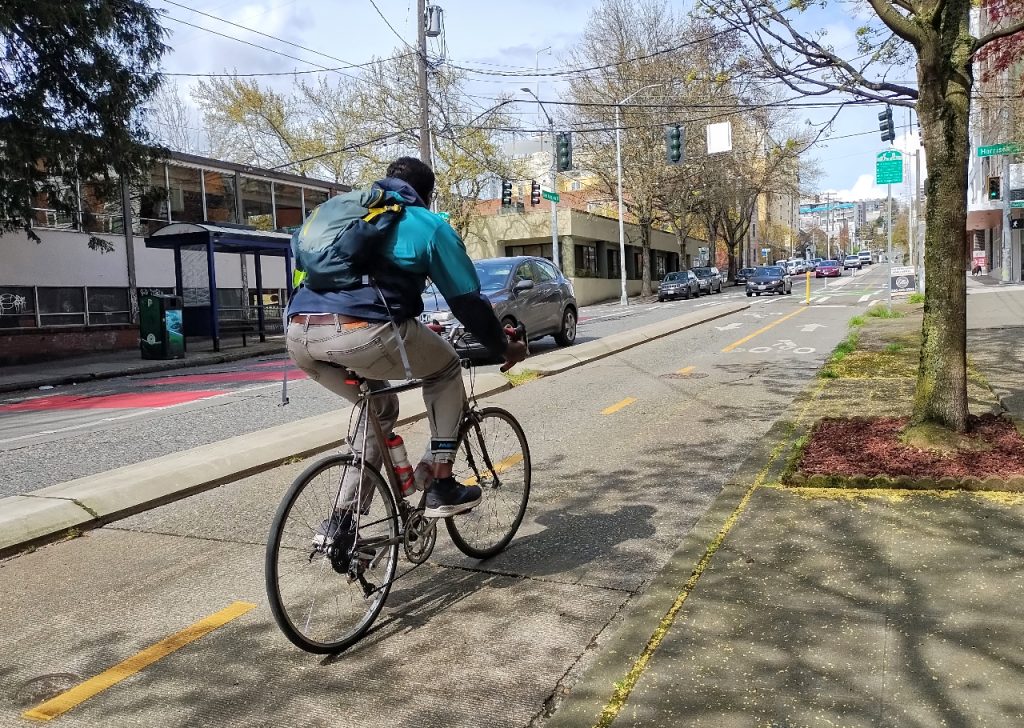
The proposal would spend $107 million on safety improvements, including 12 corridor-wide projects targeting the “high-injury network” where the most fatal and serious injury crashes occur. Another $94 million would be spent on bicycle facilities, though SDOT is holding back on targeting an exact number of mileage after falling short on its goal of adding 110 miles via Move Seattle. Those funds will also be spent on upgrades to 30% of the city’s existing bike lane network, adding more substantive barriers to increase the strength of the overall all-ages-and-abilities network.
Subdued transit investments
Promises around improvements to public transit routes are not as ambitious as Move Seattle, a clear reaction to the ability of the city to deliver just three of the seven full transit corridor upgrades promised in 2015. The new levy would invest $121 million on transit upgrades, including two full-corridor upgrades on the Route 7 and the Route 36. King County Metro is already pursuing (albeit belatedly) a full upgrade to RapidRide for the Route 7 corridor, work that will obviously coincide well with the planned repaving of north Rainier Avenue.
But SDOT is touting the ability to deliver 160 transit spot improvements over the next eight years, and improve east-west access on another two corridors that connect to light rail.
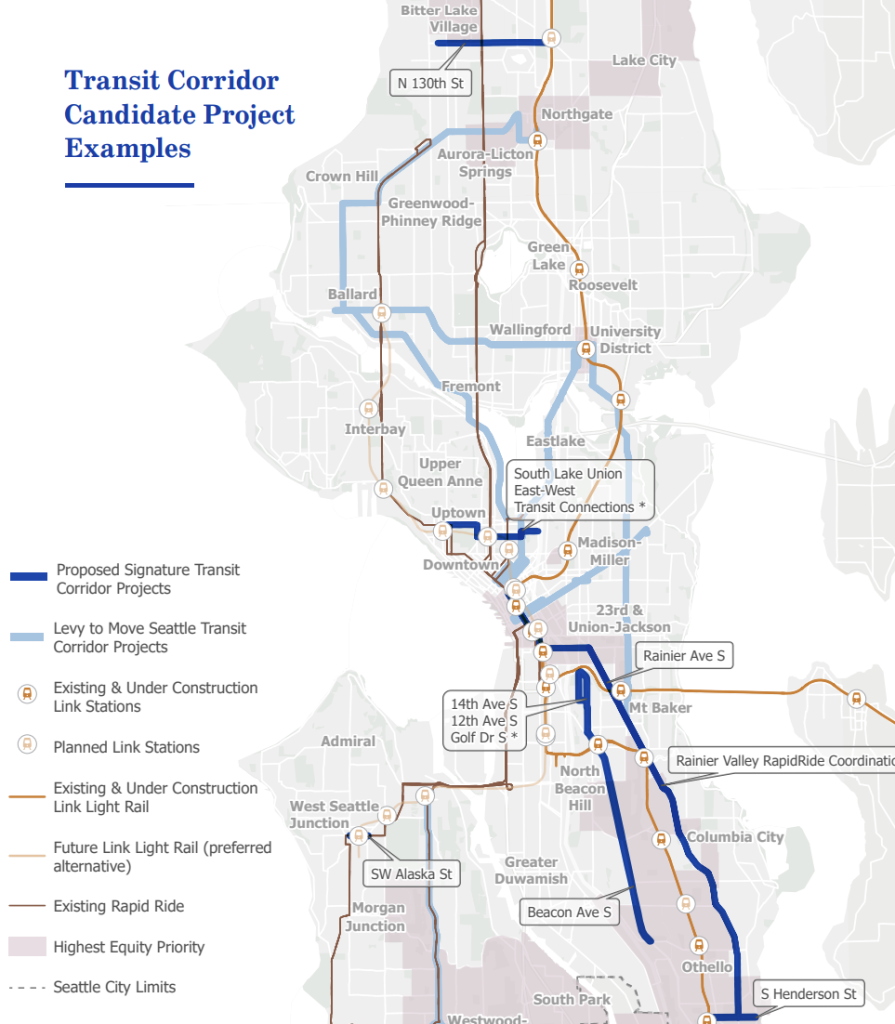
Investments in the public realm
Another $57 million would be spent on making public spaces more inviting, one of the vaguest — but potentially most exciting — programs proposed. Investments here could take the form of traditional safety improvements, upgrades to bus stops and pedestrian lighting, but also people streets, public art, or cafe streets, depending on community demand and engagement. Just don’t expect that funding to go toward pedestrianizing Pike Place Market anytime soon.
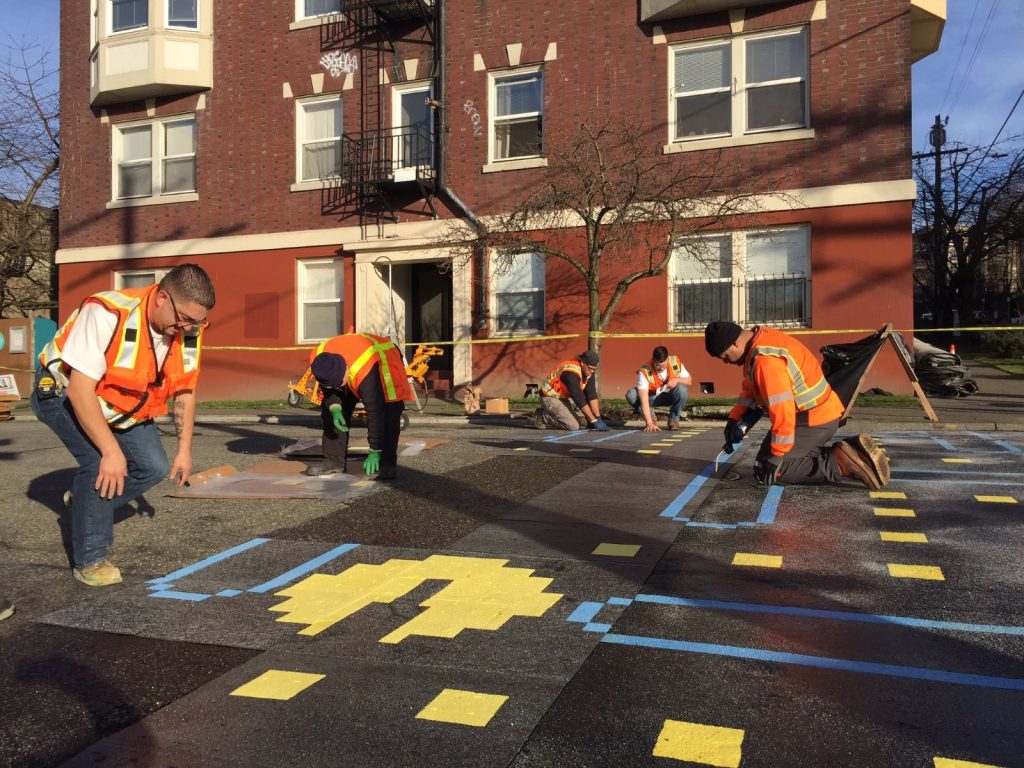
The levy proposal also includes $49 million in investments directly related to climate change, including electric vehicle infrastructure, but also funding for expanding the city’s tree inventory and management of the existing canopy, and additional planning for the three “low pollution neighborhoods” that can be traced back to a 2017 pledge as part of the C40 Cities network.
Political consensus is likely
When Mayor Ed Murray proposed the Move Seattle levy in 2015, expanding the previous Bridging the Gap levy from 2006 from $365 million to $930 million, there was considerable pushback. The Seattle Times editorial board urged voters to reject the levy, calling it a “grab-bag of diffuse spending, buttering money around in seven-figure chunks that fit City Hall’s urbanist-at-all-costs agenda.” In the end, though, the package passed by over 17 points. This year, there is likely to be much more support behind Harrell’s proposal, both because of the relatively modest size of the total increase proposed, but also due to the city’s performance on the goals laid out in Move Seattle.
Out of 30 programs funded by Move Seattle, SDOT currently claims victory on all but three, with the bicycle safety and multimodal corridor programs, along with the standalone Graham Street infill light rail station (in Sound Transit’s control), on the short list of programs where it doesn’t expect to meet the goals put before voters in 2015. There will likely be considerable debate over some of those green checkmarks, including the bridge seismic upgrade program, where a plan to tackle the key Ballard and Fremont bridges was instead detoured to other bridges that had lower price tags for upgrades.
But despite setbacks that included a high-profile “reset” of levy goals to more align with how projects were actually getting delivered, and delays caused by the Covid-19 pandemic and concrete workers’ strike in 2021-2022, there seems to be broad agreement that Move Seattle moved the city in a positive direction. Earlier this week, at a transportation forum hosted by the Seattle Metropolitan Chamber of Commerce, transportation chair Rob Saka, who has been in the role for only three months, said he thought Move Seattle had overall been successful. Saka credited, in part, the levy’s oversight structure, which includes a volunteer board to monitor progress on overall goals.
“To the extent that the levy has been successful, and I think it has overall, it’s in large part to dedicated volunteers who sacrificed their time, their talents, and their energy — they devote all of that to making our city a better place,” Saka said.
Earlier this year, the oversight committee issued its formal recommendations for the next levy, saying the city should not only pursue a more ambitious levy renewal package, but also additional forms of transportation funding to ensure that the city doesn’t continue to fall behind.
Once a final proposal lands at the City Council sometime in May, the work to wrangle amendments on issues important to individual councilmembers will begin — one of the most substantive proposals that this new city council will work on after weeks of getting up to speed on the basic machinations of city government.
“I’m charged with making sure that we have a levy renewal package that can pass the second floor of the council and has as many — not all — of our various respective priorities as possible,” Saka said this week. “And that I’m as reasonably confident as possible can pass if put before voters. That is no small feat.”
Most of the lift, however, has been done for Saka, with a modest renewal proposal crafted by the Harrell administration that keeps the city on its current trajectory without ruffling too many feathers.
Ryan Packer has been writing for The Urbanist since 2015, and currently reports full-time as Contributing Editor. Their beats are transportation, land use, public space, traffic safety, and obscure community meetings. Packer has also reported for other regional outlets including BikePortland, Seattle Met, and PubliCola. They live in the Capitol Hill neighborhood of Seattle.

